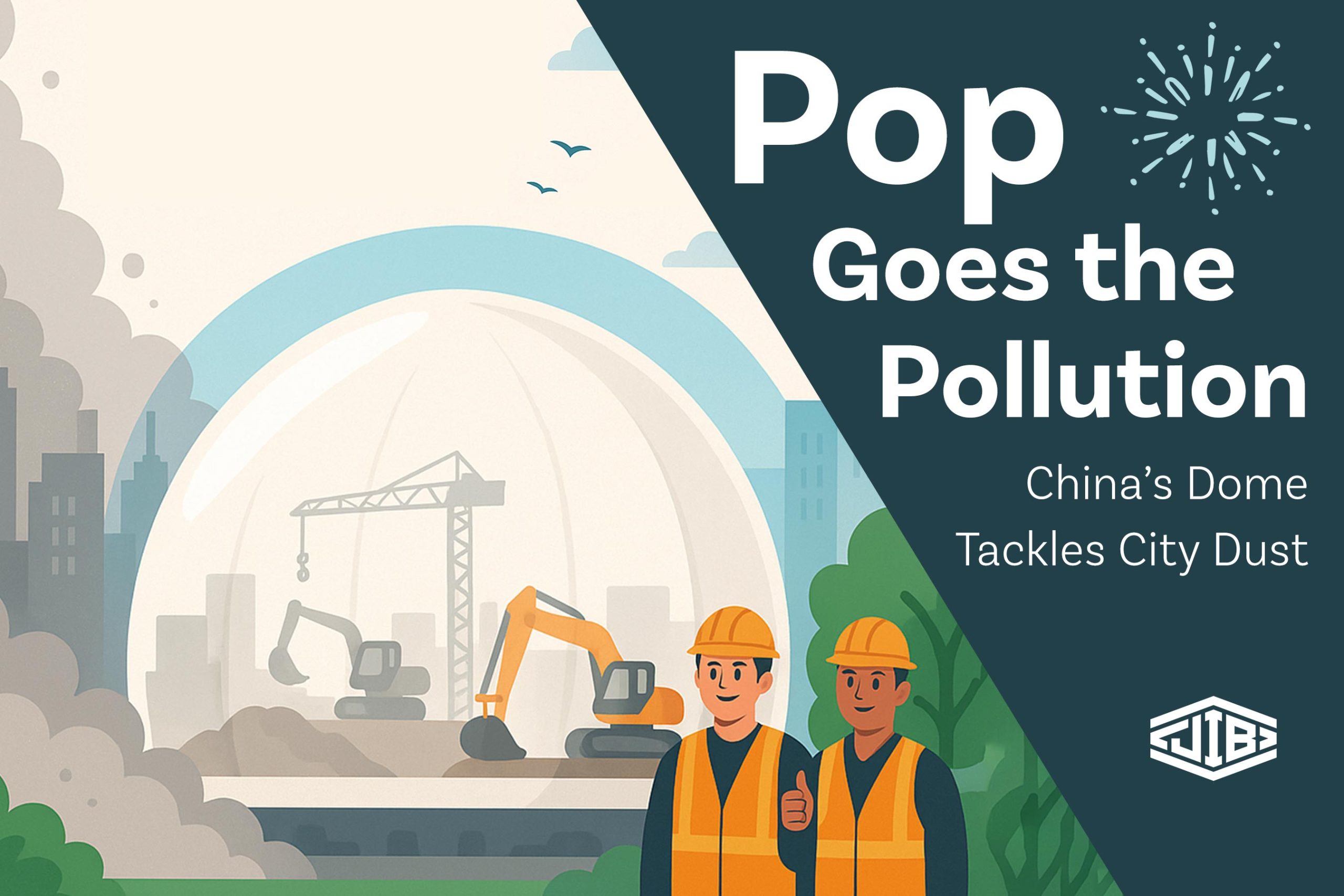In the heart of Jinan, China, a giant white dome rises over a downtown construction site, looking like a cross between a spaceship and a colossal marshmallow. Locals have nicknamed it the “big white balloon,” but this futuristic bubble has a serious mission: to keep city life clean and quiet while the skyline continues to grow.
At 50 meters tall and covering 20,000 square meters, the dome is said to be the largest of its kind in the world. And while it might look whimsical, it’s quickly becoming a symbol of how urban development can coexist with community well-being—and perhaps even hinting at the future of how we build in dense cities.
A Bubble for the Urban Blues
Construction in cities is usually synonymous with chaos: dust swirling into nearby homes, relentless jackhammers echoing off high-rises, and streets coated in grit. For residents living near downtown projects, it’s an everyday headache, and a health concern.
Jinan’s inflatable dome is aiming to change that story. The giant cover completely encloses the construction pit and machinery, trapping dust and muffling noise. Instead of construction dust drifting into apartments and businesses, the mess stays inside. City officials were motivated to try the dome because the project sits close to homes, a university, and historic landmarks, where air quality and peace are precious commodities.
The innovation isn’t just about comfort. It’s part of China’s push for greener, low-carbon cities. As urban areas become denser and more people demand a better quality of life, traditional construction methods that spill dust and noise into neighborhoods are becoming increasingly unacceptable. Enter the giant bubble.
How the Dome Works
So how does a giant inflatable structure tame the chaos of a construction site?
The dome is essentially a massive sealed balloon made of high-strength fabric coated with a reflective material that resists UV rays, fire, and harsh weather. It’s thin, at just a millimetre or so, but incredibly strong. Dozens of steel cables lace over the dome, anchoring it securely to the ground.
Instead of metal beams, the dome stays upright thanks to air pressure. Huge industrial fans constantly pump air inside, keeping the bubble inflated. That means there are no interior columns or obstructions, leaving the entire excavation pit clear for cranes, trucks, and construction crews to work.
Building the dome is surprisingly fast. Crews roll the fabric over the site like a giant blanket, and the fans do the rest. In Jinan, the dome inflated in under 10 hours, slowly rising into a smooth, white curve that now towers over nearby rooftops.
Inside, it feels like stepping into an indoor sports arena. The dome keeps out rain, snow, dust storms, and scorching summer sun. Workers operate under stable conditions year-round, shielded from the weather. The fabric blocks over 90% of UV rays and reduces heat, making it cooler in summer and warmer in winter. Giant fans circulate fresh air, while sensors monitor dust levels, air pressure, and temperature in real time. If dust kicks up from drilling or excavation, misting systems capture the particles before they escape, ensuring clean air both inside and outside the bubble.
When the job is done, the dome can be deflated, dismantled, and reused at another site, a portable solution for construction in tight urban areas.
A Win for Construction Workers
Life on a construction site is tough. Workers endure extreme temperatures, harsh weather, and constant noise. Jinan’s dome offers them a significant upgrade.
Instead of sweating under the open sun or shivering in freezing winds, crews work in a climate-controlled environment.The dome provides shade and blocks UV rays, while its insulating fabric helps maintain more stable temperatures. That’s not only more comfortable—it’s safer, reducing risks like heatstroke in summer or ice hazards in winter.
The dome also acts as a giant dust filter. In traditional open-air construction, fine dust from excavation and concrete mixing can end up in workers’ lungs, leading to respiratory issues over time. Inside the dome, dust is contained, captured by misting systems, and filtered before any air leaves the structure. This means healthier air for the people doing the heavy lifting.
Noise is also less brutal under the dome. While machines still make plenty of racket inside, the curved fabric absorbs and diffuses sound, reducing the constant roar. Workers have reported that it’s quieter and less stressful to work in the enclosed space, helping reduce fatigue and mental strain over long shifts.
And with a sealed perimeter, safety improves, too. There’s less risk of debris flying off the site, and entry points are controlled, keeping unauthorized people out. It’s essentially turning a chaotic outdoor worksite into a giant, high-tech indoor workspace.
Breathing Room for the City
For residents around the Honglou 1905 project, the site currently under the dome, the benefits are immediate. Once the bubble went up, neighbors noticed the difference right away. Windows stayed cleaner. The air smelled fresher. And that bone-rattling percussion of pile drivers and jackhammers became a distant hum.
Noise measurements outside the dome show reductions of 20 to 40 decibels, transforming ear-splitting construction noise into a background murmur similar to city traffic. For nearby schools, hospitals, and homes, that’s a life-changing improvement.
Dust emissions have dropped dramatically as well. City officials estimate the dome could prevent tens of tons of particulate matter from escaping into Jinan’s urban air over the course of the project. That’s good news for people’s lungs, but also for businesses. Shops and restaurants near the site don’t have to worry about dust covering their signs, tables, or merchandise.
Visually, the dome is turning heads, too. Instead of staring at an ugly excavation pit or tangled scaffolding, passersby see a smooth white shell that some say looks like a giant pillow or the friendly robot Baymax from the movies. It’s even become a quirky local landmark. Rather than a symbol of disruption, the construction site has become a conversation piece, and a point of civic pride.
The Future of Urban Construction?
Jinan’s giant dome may look like a novelty, but it represents a serious step forward in rethinking how cities build.
China’s national and local governments are watching the project closely. If the results continue to impress, cleaner air, quieter streets, faster construction timelines, it’s likely that inflatable domes could become common over major urban construction sites, particularly in dense neighbourhoods where people live and work right next to development.
Other cities in China, including Beijing, Shanghai, and Shenzhen, have already experimented with smaller versions of inflatable construction covers. Jinan’s record-breaking bubble shows the technology can scale up to big projects, offering a powerful tool for sustainable urban growth.
The approach could even catch on worldwide. Around the globe, city dwellers have grown increasingly intolerant of pollution and noise from construction. Giant inflatable domes could be a game-changer, especially in places with strict environmental laws or where construction is happening in historically sensitive or densely populated areas.
Of course, there are challenges. The domes require constant power to stay inflated, and they’re not cheap to build. But the long-term savings, in avoided fines, faster timelines, and healthier communities, could make them a smart investment.
For now, Jinan’s giant white bubble stands as a symbol of what’s possible when technology and urban design work together. It’s a bold reminder that cities don’t have to choose between growth and livability. Sometimes, the solution is as simple, and as spectacular, as blowing up a balloon.
Want to See the Dome in Action?
Wondering how storytelling and smart marketing can advance offsite construction, mass timber, and sustainability in North America?
Whether you’re in AEC, sustainability, or shaping the built environment, we’d love to connect. Let’s talk – or explore BuildBetter.Marketing.
Structure needs story. Jib delivers.











